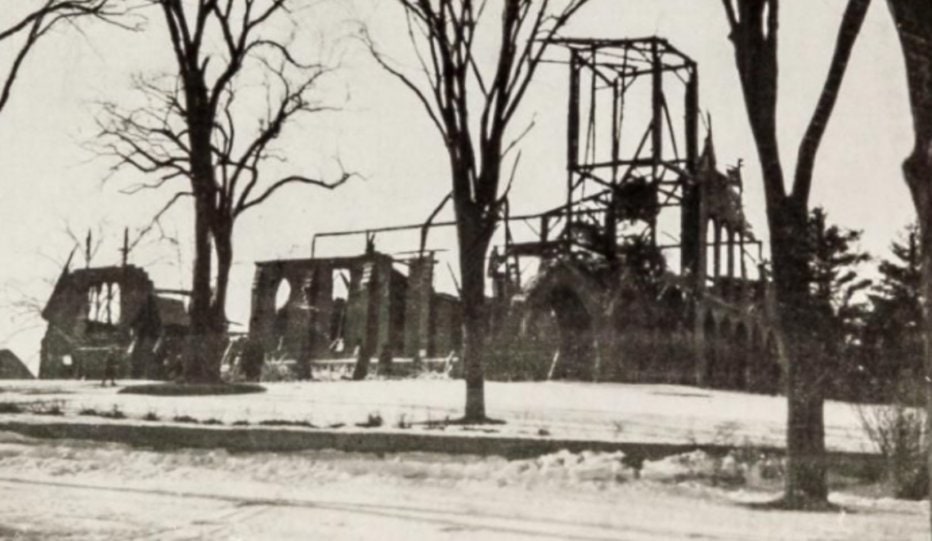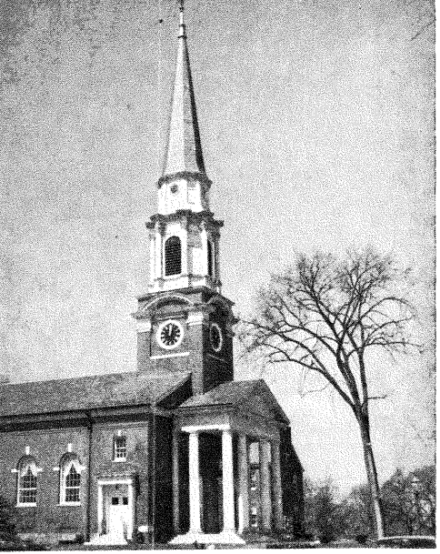
News

1923 : A New Sanctuary from the Ashes
October 11, 2023
“God makes more of us together than we can be apart”. Rev. Sarah Sarchet Butter
We will never know if Rev. Stanley Ross Fisher spoke that sentence, but the story beginning after the fire in 1916 shows that he definitely understood its meaning.
In the history of the Wellesley Congregational Church there had been two earlier buildings. The third edifice, burned to the ground on the last Saturday night of 1916. In truly nimble fashion, morning worship the next day was invited into the Town Hall, even while the fire site was still hot and smoky. One can imagine prayers of shock and bewilderment — the deepest sense of loss was yet to come. Yet, even before the smoke had fully cleared, a committee to rebuild the church was being formed, and it was one that understood how its immediate and thoughtful action would help soften the loss, restore hope, and ultimately erect a new building.
They quickly went to work, but that is not to say that the work went quickly. Initial decisions were simple with little controversy. First, the new building would stand on the original site; that was certain. Also, as a building complex, the first part to be built would be the parish house and chapel. Then, for the overall design, the committee sought an architect, and this may be the time when Rev. Fisher realized, as much as anyone could, the sort of financial challenge this would be for a spiritually healthy, but not especially wealthy congregation.
The firm of Carrére and Hastings, Architects, was not the only one offering to design a new church, but it was the one selected. With its main office in New York, it had a nationwide presence. Ahead of its competition, the firm was routinely incorporating structural steel in its designs. Its works already included the New York Public Library and the House and Senate office buildings in Washington. Locally, the Cheney-Balzer mansion, at Elm Bank, next to the Charles River, was in its portfolio. Thomas Hastings, the younger partner, grew up with a religious legacy. His father was Dean of Union Theological Seminary, and his grandfather, Thomas Samuel Hastings, was a church musician and composer of the hymn, Rock of Ages. It is no surprise that Carrére and Hastings enjoyed designing churches, enough so that a similar church, a virtual partner in appearance to Village Church, stands in Montclair, New Jersey.
Based on their conversations with Mr. Hastings, and the general design he proposed, the building committee chose his firm to design the new sanctuary.
The committee did not choose the lowest bidder, the fees for Carrère and Hastings were consistent with the size and character of its portfolio. Even before the soil was turned for a new cornerstone, it was clear that the insurance settlement from the fire, about $30,000, would fall far short of the full cost of the new church when it was complete and dedicated on October 21, 1923. The building committee knew all that, and they kept track of the mounting costs as construction continued once the design drawings were printed. Members of the Congregation must have wondered, or even doubted how the church would pay for the entire project. And while such wondering played in the mind of Rev. Fisher, the (sole) minister, he took on the task of finding a way to raise the necessary funds.
A walk around the sanctuary today will give you a clue of what Rev. Fisher proposed. On several of the large columns supporting the ceiling, you will see small brass plates specifying the chandeliers in the bays, or the bays themselves, all gifts supported by individual members of the church or their families, such as Kingsbury and Chutter and Hubbard and Fisher.
The south transept is marked reciting scripture and the name of an active member who, in fact, did not live to see the dedication of the new sanctuary. High in the steeple hangs “The Children’s Bell”, installed as a gift from the children themselves. The tower clock, which still accurately shows the time, was another memorial gift. The pipe organ, which originally stood in chambers on either side of the chancel, was yet another gift, as was the main glass entry in the narthex. By promoting the huge challenge of a new sanctuary in terms of its smaller components, and offering them for subscription at more affordable costs, Rev. Fisher spread the words of hope and possibility.
And it did not end with the bricks and mortar. The church furniture was on the list. Chancel pews, the original baptismal font, and even an acoustic panel, suspended over the pulpit and necessary before a microphone and speaker; all these became named gifts to the church from individuals or their families. By the time the church was dedicated, on Sunday, October 21, 1923, it was virtually complete and finished; a sanctuary promised for more than five years, now finished.
*************
Finished though it was, it was neither the end nor the beginning of the story. September 6th, little more than a month ago, marked the 225th year that has passed since the Parish in the Precinct of West Needham was organized, a trail of many years marked with faithful congregational worship and a continuous mission of service to others in God’s creation. The earliest history names 10 church members who joined one another in a covenant which guided them to share their spirituality in ways we still recognize today. With their individual efforts, they labored into existence the first meeting house, and later, the first pews were crafted by carpenters who were members. Furthermore, in that period of the 19th century, we can be sure that as repairs were needed, it was the members themselves, their time and sweaty effort that completed the work; gifts of far greater measure together than they could ever be separately.
As for the sanctuary standing today, as it has for 100 years, the same truth continues. Modifications and renovations have been done at least three times in the past century. The building now has improved classrooms, it complies with modern safety codes, and it is accessible for anyone with limited physical abilities. Even as repairs have been necessary, in this very year among many, the skilled hands-on effort of members has been important, just as it was when the bricks were first laid and the paint was fresh.
When a building is celebrated because of its age or architecture and nothing else, it becomes a monument, a relic, a symbol of something in the past. Because Wellesley Village Church has gathered and prayed continuously for more than two centuries, and has kept its discerned mission in view through all those years and challenges, its building is far more than just a monument. One knows that simply by being inside. To be welcomed on Sunday by hearing that God makes more of us together than we can (ever) be apart, is to hear the echoed welcome of 100 years ago, when Rev. Fisher inspired the congregation to complete the construction. Dedicated over an entire week beginning Sunday, October 21st, 1923, the walls reverberated with a magnificent celebration, and the people surely said, “Amen”.
Bradford Harding, Village Church Historian
All material for this article is in the Village Church archives.

